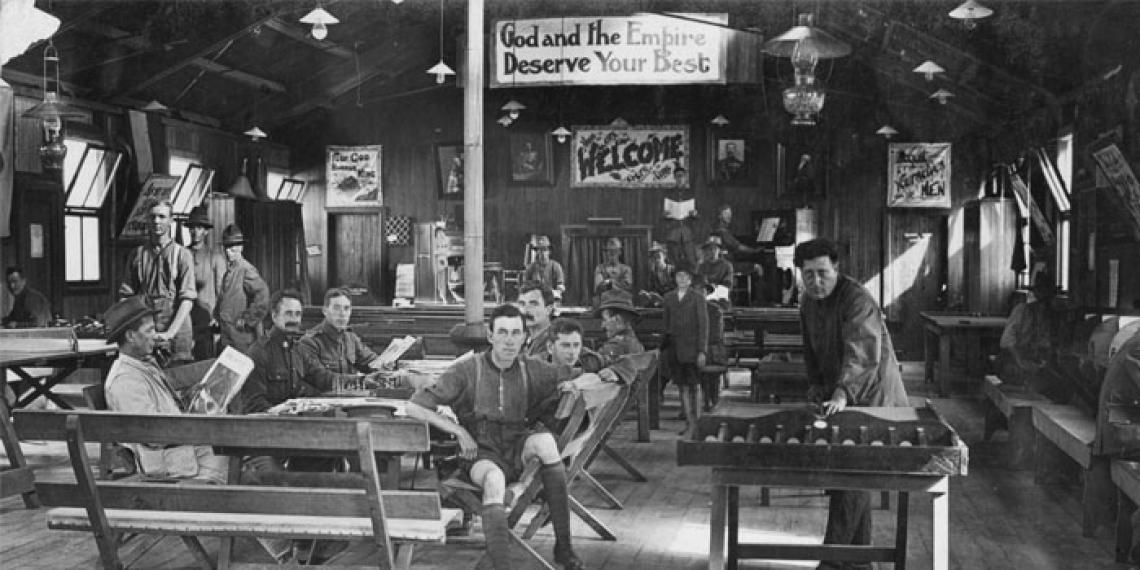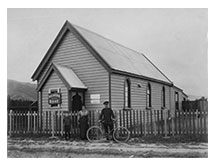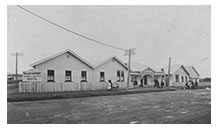You are here
Helping the troops at home

The immensely popular Salvation Army Institutes, set up in New Zealand Army camps during World War I, were places where soldiers could find both solace and a ‘gladsome song’.
First in the field and foremost ever since’ is a saying that applies to The Salvation Army’s work among the troops in New Zealand. When Britain declared war on Germany on 4 August 1914, the New Zealand Government offered its armed forces to Britain to assist in the war effort. The Salvation Army in New Zealand —through its Territorial Commander, Commissioner H.C. Hodder—also offered the services of its officers to assist the government in any way possible, which was immediately accepted by the Defence Department.
A number of officers were already commissioned as chaplains and were working in temporary territorial camps around New Zealand. When war was declared, The Salvation Army concentrated its resources in the permanent camps which trained troops heading overseas, at Trentham, Featherston and Tauherenikau. The Salvation Army ‘Institute Marquees’ provided a place for meetings and recreation, as well as writing letters or just talking, with the help of ‘an Army cuppa tea’.
Salvation Army Institutes became increasingly popular: large buildings replaced the marquees, extensions were added, new and still larger buildings built, and the Institute became bigger than anything else in the camps. Yet there was rarely room enough for all the troops wanting to attend the church parade or utilise the facilities.
The Institutes were well equipped for games and there were comfortable rooms for reading and writing, or meeting visiting family members. One of the main features of the Institutes was the Sunday night Song Services, which were very popular.
The following extract from a series entitled ‘Life in Camp’ shows how the Army brought cheer to men in every camp: By six o’clock soon after the men have finished tea, they begin strolling into the Institute, and a concert develops easily if there is a guiding spirit to banish shyness. The chaplain knows the acts of galvanism, and he does not allow deadness or dullness to tarry in his building. If he sees new men sitting about listlessly—with that far-away look in the eyes on the evening of the first day, he finds someone who will break in upon their thoughts with merry music or a gladsome song, with a swinging chorus and soon the serious one is drawn into the gaiety.
The duties of the chaplain and welfare staff were many and various. Not only did they have to lead a rousing meeting, they also had to be able to gain the confidence of the men—for a large portion of their services to the men were of a personal nature. With the calling up of married men this increased considerably.
There was always substantial correspondence and a continual stream of callers: one man wants a will prepared, the next is a probationer and has to report regularly to the chaplains, the next requires advice about his allotment money, the next asks for a New Testament—and very often such a request was an excuse to seek spiritual guidance, which resulted in the man accepting Christ as his saviour.
The next man is to be court martialled in a few days and is brought to the Institute under escort, asking the chaplain to appear on his behalf. Another has personal or family trouble and wants to talk and confide in the chaplain. Yet another has a few valuables that he wants the chaplain to put in his safe for him.
 So, one after another, they come and find a sympathetic ear and a willing friend, and very often just the help they need, records The Salvation Army’s All The World publication in 1919. The simple secret was that the Salvationists were serving not only the soldiers, but God.
So, one after another, they come and find a sympathetic ear and a willing friend, and very often just the help they need, records The Salvation Army’s All The World publication in 1919. The simple secret was that the Salvationists were serving not only the soldiers, but God.
The Featherston Camp housed 8000 men and was on the outskirts of the very small Wairarapa town, with little accommodation for visitors. Salvation Army chaplains rallied to get a hostel built, with 40 rooms for relatives and friends. The hostel was booked out before it was opened.
More hostels or accommodations were built around the country, supplying 50,895 beds and 115,647 meals. The Otago Daily Times reported on 5 April 1917, that ‘the provision of this accommodation made it possible for mothers and wives and sisters to enjoy hours of association with their men that will be, in many cases perhaps a precious memory for the rest of their lives’, as sadly, many men would not return home.
Adjacent to every camp were the various military hospitals, which were regularly visited by women Salvationists bringing fruit, sweets, comforts and various necessary articles. During their visits, the Salvationist sisters would receive many requests from the men—such as help to write a letter to a mother, wife or friend, pack a parcel and post it, or call on a relative.
Many of the newly established Salvation Army Home Leagues provided gifts and distributed these to the troops in hospital. They also sent gifts and comforts to the troops overseas. If a soldier wanted to get in contact with relatives, the Army, through its network of corps (churches), was very successful in liaising with relatives.
 As the war progressed, The Salvation Army saw the need to provide support services and help to returning soldiers. When troop ships returned to New Zealand, they often found a Salvation Army band playing as the troops disembarked. The chaplains would be on hand to offer support and make soldiers aware of what was available to assist them in their return home.
As the war progressed, The Salvation Army saw the need to provide support services and help to returning soldiers. When troop ships returned to New Zealand, they often found a Salvation Army band playing as the troops disembarked. The chaplains would be on hand to offer support and make soldiers aware of what was available to assist them in their return home.
Many men required accommodation, and the Salvation Army built a hostel for returned servicemen at the cost of £16,500 on the corner of Vivian and Tory Streets in Wellington. Here, men could stay until they were able to get work or return to their homes.
The Government established hospitals for returned servicemen in Rotorua because of the curative properties of the local thermal springs. But many men were from out of town and it was difficult to find somewhere to stay during their treatment. With the opening in 1915 of The Salvation Army Soldier’s Institute, men were able to avail themselves of this well-equipped Institute, which included reading rooms, recreation rooms, a lounge and a large tea room, along with comfortable accommodation. Because of its popularity, the Institute underwent several additions. An adjacent hall was used for services and could accommodate 400–500 men.
The Institute provided a motor launch named Florence Booth, which took recuperating soldiers out on the waters of the lake, where fishing engaged their minds. A motor car was also available for restorative trips into the country.
The officer in charge of the Institute was Captain Sam Hayes, who was himself a returned soldier after losing a leg in action. His assistant, Captain Shearer, had seen active service and been badly gassed.
A ‘Red Jersey’ appeal was mounted to help with these Salvation Army ventures. Because of the immense appreciation and generosity of the public at large, £100,000 was collected. As was reported in All the World: ‘Everywhere the soldier goes the Red Jersey is with him; from the time he enters camp the Army has a warm heart and a helping hand for him. Well or sick, free or in prison, a red jersey or a blue bonnet will find him and comfort him.’
by Garry Mellsop (c) 'War Cry' magazine, 18 April 2015, pp10-11.
You can read 'War Cry' at your nearest Salvation Army church or centre, or subscribe through Salvationist Resources.